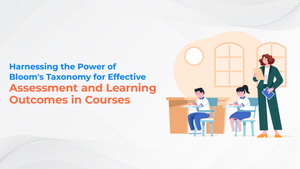In today's environment, Learning Management Systems are an essential tool for every institution. There was a time when books and libraries were used before the internet wave. Several decades ago, teachers provided all of the information and were the only sources of validation of knowledge. Students are no longer limited to one type of information due to the disruption of technology and its various avatars, such as smartphones, social media, personal computers, and others.
Moreover, it is particularly important because it is imperative that students be able to cope with the rapidly changing and growing scientific and technological advancements in all areas of study. With the help of this blog, you will gain a deeper understanding of Learning Management Systems, and what they can be if they are future-ready.
LMS in the current scenario
A learning management system (LMS) is a website-based learning environment that is an alternative to learning in a classroom. It can be accessed via the cloud. Course materials can be created, and integrated, learning goals are outlined, content and assessments can be aligned with outcomes, learning paths can be tracked, and customized assessments can be created for a more focused learning environment.
A majority of people believe that using a learning management system results in a minimal level of interaction between students and teachers, a loss of clarification, difficulty adapting to teachers or curriculum, manipulation of curriculum, and so on. In order to compete for an unprecedented future, a future-ready LMS should possess the following features.
LMS powered by AI
AI LMS has enormous options for personalized learning, outlining an enriched learner journey. Until AI LMS, digitally catering to a customized learning environment was quite challenging. An AI-powered LMS recommendation engine offers a user-focused UI, with auto filtering of contents suggested to individualized learners gathered by intelligence from user behaviors, skill sets, and information pieces.
This pools out a broad range of related content to its users insightfully without prompting. From a learner’s perspective, there is an increased learner engagement due to this feature where the learner feels content that the content is tailored to his knowledge level and requirement. Indeed, AI is starting to take off as a forward-looking LMS feature. Online learning platforms, such as BrainCert, go beyond basic LMS functionality by incorporating social learning features into the platform.
Technology grows to understand each learner’s behavior, creating unique, personalized learning experiences, and social learning lets learners consult peer mentors, ask questions, and collaborate.AI gives a company not just the ability to wow users, but the freedom from repetitive tasks. With AI, you’re still getting to create content, but then you’re able to pass the baton and let the system take care of the more tedious tasks such as reviewing charts and statistics.
Flipped Learning
Students are tech-savvy these days. Flipped Learning is where the traditional classrooms are flipped from the traditional way and gives an opportunity to students to learn even before they come into the class.
This gives more time in class for students to grasp the concepts, find solutions, practice, and ask for clarifications. Instead of homework, students check their understanding and extend their learning.
A future of Learning Management System LMS must be user-friendly and compliant for flipped learning and schedules must be entered into the LMS for better understanding and cooperation from the students.
Reliability and Flexibility
The most critical requirements of an LMS are reliability and flexibility. An LMS is an important part of our company, it should quietly work in the background and have the flexibility to support the evolving needs of associates, and their supervisors. It’s great to offer out-of-the-box functionality and standard features for organizations that need an all-in-one solution. However, a great LMS also should enable Learning professionals to tap into their creativity to develop learning curricula, programs, and processes that best meet the needs of the people in their organization.”
Learning professionals—and the learners themselves—want their learning management system to be efficient and flexible. Searching for content should be quick and easy. Navigating should require as few steps as possible. On the administrator side, the same feedback applies. Administrators want their learning technology to make administration faster and more thorough. When an organization starts looking for new learning technology, it’s often because they feel the technology is working against them, and making administration more difficult.
Adaptability and keeping the needs of learners in mind are key, Mobile allows learners to fit learning into their busy schedules. Learning solutions should shape the availability of their functionality to meet the needs of a modern, on-the-go learner who has 5 to 10-minute bursts of available time spread throughout the day. A micro-sessions format means the content should be designed to fit into these windows with well-defined objectives, with the user interface designed to deliver feedback while in the flow to the learner.
Multiple Learning Methodologies
- The solution facilitates multiple learning methodologies like online, blended, instructor-led, in-class, remote, social learning, and mobile learning. E-learning provides a framework for subject matter experts to create new online courses and publish them quickly. It enables massive pieces of training, anytime, anywhere learning, and facilitates formal and informal learning.
- A collaborative learning group is created for each training instance, and the trainer for the course is assigned as the expert who drives the respective group. “The trainer shares class assignments with the group and drives discussion forums. Members of class participants have access to the shared articles, blogs, announcements, and knowledge center courses, and they take part in discussion forums.
- There also is a desire for systems that help employees carve their own career paths and get reskilled when necessary. The biggest thing on everyone’s mind right now is how to reskill workers. With so many jobs going away due to automation, every company now is turning into a learning organization. In addition, companies are focused on helping employees find their own career paths, and upskilling and reskilling play a huge role in this. However, when it comes to training employees, we go back to the importance of driving voluntary adoption and engagement of the LMS.
More Self-Serve/Self-Management and Better Communication
Future LMS development phases will include more self-serve and self-management and updating capabilities by the member training administrators, especially for custom learning paths incorporating their own courses and custom resources.
The company’s dream system would facilitate communication more powerfully. We hope to build more intra-company and network communication among learners, content sharing, and enhanced ability to create secure course links that can be utilized and sent outside of the LMS that will allow promotion to students, as well as the ability to launch and track course activity.
The company would like its LMS of the future to help transform more of its learning content to online formats to assist with the effective movement of training offline to online, as needed and as appropriate, and as quickly as possible due to unprecedented circumstances.
Conclusion:
Technology has created a wide array of new markets globally, and the LMS market is no different. If you’re looking to join the masses and adopt or change your LMS, then BrainCert has resources that can help. It has all future-ready elements to call it a contemporary, versatile, customizable, and easy-to-use LMS. Every new feature and every bit of interface is designed to save your time and effort, making teaching and learning easier.










